

Nathanmarz/specter. How to improve ClojureScript performance. Clojure-cookbook/4-14_read-write-clojure-data-structures.asciidoc at master · clojure-cookbook/clojure-cookbook. "Agility & Robustness: Clojure spec" by Stuart Halloway.
Spec Guide. Clojure programs rely heavily on passing around maps of data.
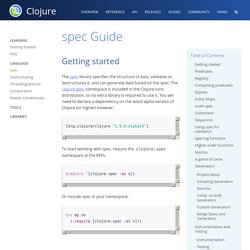
A common approach in other libraries is to describe each entity type, combining both the keys it contains and the structure of their values. Rather than define attribute (key+value) specifications in the scope of the entity (the map), specs assign meaning to individual attributes, then collect them into maps using set semantics (on the keys). This approach allows us to start assigning (and sharing) semantics at the attribute level across our libraries and applications.
For example, most Ring middleware functions modify the request or response map with unqualified keys. However, each middleware could instead use namespaced keys with registered semantics for those keys. Entity maps in spec are defined with keys: Pretty-print.net - Format Data and Code. Spec-ulation Keynote - Rich Hickey. Building composable abstractions - Eric Normand.
Web development. Test Driven Development. Casting SPELs with Clojure - Home - Anyone who has ever learned to program in Lisp will tell you it is very different from any other programming language.
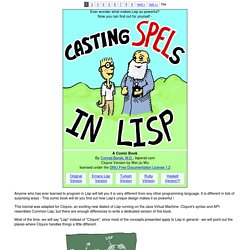
It is different in lots of surprising ways - This comic book will let you find out how Lisp's unique design makes it so powerful ! This tutorial was adapted for Clojure, an exciting new dialect of Lisp running on the Java Virtual Machine. Clojure's syntax and API resembles Common Lisp, but there are enough differences to write a dedicated version of this book. Most of the time, we will say "Lisp" instead of "Clojure", since most of the concepts presented apply to Lisp in general - we will point out the places where Clojure handles things a little different.
Since Clojure is based on the JVM, you will need to have Java installed on your system. For the examples in this tutorial, simply unpack the archive, open a command line tool and switch to Clojure's main directory. The introduction to Reactive Programming you've been missing. The introduction to Reactive Programming you've been missing (by @andrestaltz) This tutorial as a series of videos If you prefer to watch video tutorials with live-coding, then check out this series I recorded with the same contents as in this article: Egghead.io - Introduction to Reactive Programming.
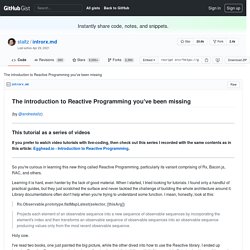
So you're curious in learning this new thing called Reactive Programming, particularly its variant comprising of Rx, Bacon.js, RAC, and others. Learning it is hard, even harder by the lack of good material. Generate Beautiful (and Correct) Documentation from Unit Tests Files. Langref.org - clojure. ClojureSphere. Light Table Workflow for Interactive Clojure Development - Safari Blog. A guest post by Timothy Pratley, who currently works for Tideworks Technology as a Development Manager building Traffic Control software for logistics clients including SSA Marine, CSX, and BNSF.

Interactive development is a big win. Being able to evaluate snippets of code without building and running your entire project makes it faster to test code. Being able to modify code and data in a running system allows you to experiment with data and operations immediately.
Clojure. CrossClj - cross-referencing the clojure ecosystem. A Concise Guide to Clojure. A Concise Guide to Clojure (under construction)Copyright ©2011, David Matuszek The following list is from which is abstracted from However, one reviewer said that the latter is hopelessly out of date.
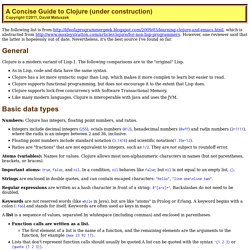
Nevertheless, it's the best source I've found so far. Clojure is a modern variant of Lisp-1. The following comparisons are to the "original" Lisp. As in Lisp, code and data have the same syntax. Numbers: Clojure has integers, floating point numbers, and ratios. Integers include decimal integers (255), octals numbers (012), hexadecimal numbers (0xff) and radix numbers (2r1111), where the radix is an integer between 2 and 36, inclusive. Atoms (variables): Names for values. A Core.logic Primer · clojure/core.logic Wiki · GitHub. Introduction This is a top-down introduction to core.logic which attempts to lead you to that elusive AHA!
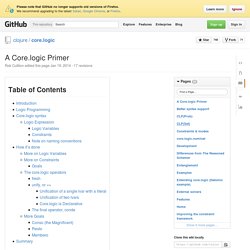
Moment of understanding what logic programming is about. We begin with a high level overview of the purpose and basic syntax of core.logic and then show a small example of the sort of questions logic programming attempts to answer. With that understanding in hand we build up from the basic logic operators to simple programs. Functional Thinking. This series aims to reorient your perspective toward a functional mindset, helping you look at common problems in new ways and find ways to improve your day-to-day coding.

It explores functional programming concepts, frameworks that allow functional programming within the Java language, functional programming languages that run on the JVM, and some future-leaning directions of language design. The series is geared toward developers who know Java and how its abstractions work but have little or no experience using a functional language.
Thinking functionally, Part 1Learning to think like a functional programmer Functional programming has generated a recent surge of interest with claims of fewer bugs and greater productivity. But many developers have tried and failed to understand what makes functional languages compelling for some types of jobs. Learning the syntax of a new language is easy, but learning to think in a different way is hard. Dave Ray - Building User Interfaces in Clojure with Seesaw. Your browser doesn't support the features required by impress.js, so you are presented with a simplified version of this presentation.
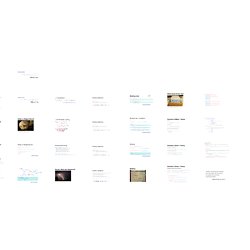
For the best experience please use the latest Chrome or Safari browser. Firefox 10 (to be released soon) will also handle it. Missed Abstractions Backwards Compatibility Neglect Arms and Legs StackOverflow Ghost Town Forums No Fun Stable, available, no dependencies Unified Abstractions Address Swing gotchas, hacks and workarounds Common case easy. Java + Swing. Lou Franco: code, apps, and writings. Last night was our Clojure event with Rich Hickey.

BTW, if you were there, regular meeting of the Western Mass Developers Group are every other Thursday at Panera Bread in Hadley (7pm) — most of the time, we just sit around and talk — very informal — hope to see you there. Back to the presentation — hopefully the slides/video/etc will be up somewhere soon — Rich focussed on the concurrency features of Clojure (Vars, Refs, and Agents). First he showed us the state of concurrency support in Java/C# today (locking) and identified the problem as having direct references to mutable objects. Thinking in Data.
Clojure Documentation. This work is licensed under a Creative Commons Attribution 3.0 Unported License (including images & stylesheets).
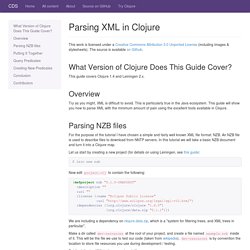
The source is available on Github. What Version of Clojure Does This Guide Cover? This guide covers Clojure 1.4 and Leiningen 2.x. Overview Try as you might, XML is difficult to avoid. Parsing NZB files For the purpose of the tutorial I have chosen a simple and fairly well known XML file format: NZB. Let us start by creating a new project (for details on using Leiningen, see this guide: Now edit project.clj to contain the following:
Structure and Interpretation of Computer Programs. Introduction to Clojure. Clojure is simple, easy, fun, and very cool. Some have said that Clojure — or a language very much like it — is the future of programming languages. Overview Clojure is a modern dialect of Lisp, targeting the JVM is designed for functional programming and concurrency, and is therefore all about immutability interoperates with Java has many interesting features such as features macros, agents, transactional memory, transients, multimethods, protocols, and namespaces is homoiconic was created by Rich Hickey The current production version is 1.4. Links. Learn Clojure in 15 minutes, perhaps.
Moving on from pointless flamebait rants, here's something a bit more constructive. Inspired by Tyler Neylon's excellent Learn Lua in 15 minutes, I humbly present my original effort at an equivalent for Clojure (also available as a gist). Further Reading This is far from exhaustive, but hopefully it's enought o get you on your feet. Clojure.org has lots of articles: Macourtney/Conjure. The Clojure Toolbox. Clojure for the Brave and True, an Online Book for Beginners.
CrossClj - cross-referencing the clojure ecosystem. Clojure Cheat Sheet (Clojure 1.3 - 1.6, sheet v16) Clojure.
Clojars. From the ground up. CodeMentors. Cheatsheet. Sean Devlin’s Videos. Clojure made-simple - John Stevenson. Clojure Tutorial For the Non-Lisp Programmer. I intend to keep this tutorial as accurate and up-to-date as possible. If you have any suggestions for changes, please leave a comment at the bottom of this page.
API. Learn Clojure. Clojure Notes. Functional programming in Clojure. Basic tools Get equipped in your fight against the dragons. Installing the developement environment JavaLeiningenEditorGitHow to submit answers to exercises Training day Get your survival skills up to shape. Structure of the exercise projectUsing the REPLPrefix syntaxDefining functions I am a horse in the land of booleans. Tips for Clojure Beginners. 1. Learn the essentials with Clojure Koans. Clojure Koans teaches you the basics of the language by providing a series of tests for you to turn green.
The topics and tests are chosen well, and the project’s vibe is pleasant (“calling a function is like giving it a hug with parentheses”). Open a koan. Light Table. 4clojure – Welcome! Clojure Testing Framework. Clojure Koans. Learn clojure in Y Minutes. ClojureDocs - Community-Powered Clojure Documentation and Examples.